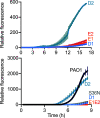Evolution of the Quorum Sensing Regulon in Cooperating Populations of Pseudomonas aeruginosa
- PMID: 35294222
- PMCID: PMC8863103
- DOI: 10.1128/mbio.00161-22
Evolution of the Quorum Sensing Regulon in Cooperating Populations of Pseudomonas aeruginosa
Abstract
In the opportunistic pathogenic bacterium Pseudomonas aeruginosa acyl-homoserine lactone quorum sensing (QS) can activate expression of dozens to hundreds of genes depending on the strain under investigation. Many QS-activated genes code for extracellular products. P. aeruginosa has become a model for studies of cell-cell communication and coordination of cooperative activities, which result from production of extracellular products. We hypothesized that strain variation in the size of the QS regulon might reflect the environmental history of an isolate. We tested the hypothesis by performing long-term growth experiments with the well-studied strain PAO1, which has a relatively large QS regulon, under conditions where only limited QS-controlled functions are required. We grew P. aeruginosa for about 1000 generations in a condition where expression of QS-activated genes was required, and emergence of QS mutants was constrained and compared the QS regulons of populations after 35 generations to those after about 1000 generations in two independent lineages by using quorum quenching and RNA-seq technology. In one lineage the number of QS-activated genes identified was reduced by over 60% and in the other by about 30% in 1000-generation populations compared to 35-generation populations. Our results provide insight about the variations in the number of QS-activated genes reported for different P. aeruginosa environmental and clinical isolates and, about how environmental conditions might influence social evolution. IMPORTANCE Pseudomonas aeruginosa uses quorum sensing (QS) to activate expression of dozens of genes (the QS regulon). Because there is strain-to-strain variation in the size and content of the QS regulon, we asked how the regulon might evolve during long-term P. aeruginosa growth when cells require some but not all the functions activated by QS. We demonstrate that the P. aeruginosa QS-regulon can undergo a reductive adaptation in response to continuous QS-dependent growth. Our results provide insights into why there is strain-to-strain variability in the size and content of the P. aeruginosa QS regulon.
Keywords: acyl-homoserine lactone; adaptive evolution; metatranscriptomics; quorum quenching.
Conflict of interest statement
The authors declare no conflict of interest.
Figures




Similar articles
-
Evolution of Quorum Sensing in Pseudomonas aeruginosa Can Occur via Loss of Function and Regulon Modulation.mSystems. 2022 Oct 26;7(5):e0035422. doi: 10.1128/msystems.00354-22. Epub 2022 Oct 3. mSystems. 2022. PMID: 36190124 Free PMC article.
-
The relationship between pqs gene expression and acylhomoserine lactone signaling in Pseudomonas aeruginosa.J Bacteriol. 2024 Oct 24;206(10):e0013824. doi: 10.1128/jb.00138-24. Epub 2024 Sep 5. J Bacteriol. 2024. PMID: 39235221 Free PMC article.
-
RhlR-Regulated Acyl-Homoserine Lactone Quorum Sensing in a Cystic Fibrosis Isolate of Pseudomonas aeruginosa.mBio. 2020 Apr 7;11(2):e00532-20. doi: 10.1128/mBio.00532-20. mBio. 2020. PMID: 32265330 Free PMC article.
-
Inhibiting N-acyl-homoserine lactone synthesis and quenching Pseudomonas quinolone quorum sensing to attenuate virulence.Front Microbiol. 2015 Oct 19;6:1173. doi: 10.3389/fmicb.2015.01173. eCollection 2015. Front Microbiol. 2015. PMID: 26539190 Free PMC article. Review.
-
Quorum sensing: cell-to-cell communication in Saccharomyces cerevisiae.Front Microbiol. 2023 Nov 23;14:1250151. doi: 10.3389/fmicb.2023.1250151. eCollection 2023. Front Microbiol. 2023. PMID: 38075875 Free PMC article. Review.
Cited by
-
Evolution of Quorum Sensing in Pseudomonas aeruginosa Can Occur via Loss of Function and Regulon Modulation.mSystems. 2022 Oct 26;7(5):e0035422. doi: 10.1128/msystems.00354-22. Epub 2022 Oct 3. mSystems. 2022. PMID: 36190124 Free PMC article.
-
Uncovering a hidden functional role of the XRE-cupin protein PsdR as a novel quorum-sensing regulator in Pseudomonas aeruginosa.PLoS Pathog. 2024 Mar 14;20(3):e1012078. doi: 10.1371/journal.ppat.1012078. eCollection 2024 Mar. PLoS Pathog. 2024. PMID: 38484003 Free PMC article.
-
Genetic and Transcriptomic Characteristics of RhlR-Dependent Quorum Sensing in Cystic Fibrosis Isolates of Pseudomonas aeruginosa.mSystems. 2022 Apr 26;7(2):e0011322. doi: 10.1128/msystems.00113-22. Epub 2022 Apr 11. mSystems. 2022. PMID: 35471121 Free PMC article.
-
The relationship between pqs gene expression and acylhomoserine lactone signaling in Pseudomonas aeruginosa.J Bacteriol. 2024 Oct 24;206(10):e0013824. doi: 10.1128/jb.00138-24. Epub 2024 Sep 5. J Bacteriol. 2024. PMID: 39235221 Free PMC article.
-
Quorum sensing going wild.iScience. 2023 Sep 22;26(10):108000. doi: 10.1016/j.isci.2023.108000. eCollection 2023 Oct 20. iScience. 2023. PMID: 37829197 Free PMC article. Review.
References
-
- Latifi A, Foglino M, Tanaka K, Williams P, Lazdunski A. 1996. A hierarchical quorum-sensing cascade in Pseudomonas aeruginosa links the transcriptional activators LasR and RhIR (VsmR) to expression of the stationary-phase sigma factor RpoS. Mol Microbiol 21:1137–1146. doi:10.1046/j.1365-2958.1996.00063.x. - DOI - PubMed
Publication types
MeSH terms
Substances
Grants and funding
LinkOut - more resources
Full Text Sources

